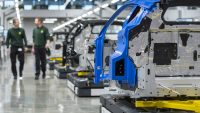You can’t have missed the launch of the latest Fiesta. Ford is undertaking perhaps its most co-ordinated campaign yet, incorporating TV, radio, internet, even local pubs and clubs. It’s the culmination of a process that started this time last year, with the unveiling of the dramatic Verve ‘concept’. Which, we now know, was actually the Fiesta, all but production-ready.
 But such tricks aren’t new for Ford. Back in 1976, it unveiled the new Fiesta – but we didn’t know it at the time. The Bobcat was meant to be just a ‘prototype’ for Ford’s entry into the small car sector. But savvy dealers found themselves, from February 1977, taking initial deliveries of a somewhat similar-looking three-door…
But such tricks aren’t new for Ford. Back in 1976, it unveiled the new Fiesta – but we didn’t know it at the time. The Bobcat was meant to be just a ‘prototype’ for Ford’s entry into the small car sector. But savvy dealers found themselves, from February 1977, taking initial deliveries of a somewhat similar-looking three-door…
This was a crucial model for Ford. The small car sector was so new back then it wasn’t even called supermini. Makers, of course, had once sold
smaller-sized models, but with each new derivative they had progressively grown – leaving an expanding gap in the range (a similar thing has happened today, with the creation of the city car). Throw in a couple of oil crises, and suddenly you’ve a public crying out for more economical models, which just weren’t on sale.
Renault and Fiat were the first to get there, with the innovative 5 and 127. These were the first front-wheel-drive cars, with a rear hatchback, into which you could pack parents in the front, kids in the back and luggage in the boot.
Oh, sure, British Leyland still sold the Mini, but even back then it was way out of date. Simply too small and compromised to be a viable family alternative, lacking the comfort to encourage people to trade down. The Renault and Fiat did – that’s why Ford simply had to get in on the act.
Following a very similar model, the Fiesta broke no new ground but was still a revelation for Ford – its first front-wheel-drive model, first hatchback, first ‘small’ car since the Anglia grew into the Escort. Engines ranged from 950cc to 1.3-litres, it was three-door only and was arguably the best-looking, neatest Fiesta of all.
Dealers adored it from the off. Why? Because customers took to it in droves. It quickly became Europe’s fastest-selling car, with half a million sold in the first year alone. That was because it was simply bang on the money. It could do 35 to the gallon, was nippy enough and, crucially, dead easy to drive.
The trims were brilliantly configured. Base gave you little (PVC seats? Mmmm), L gave you all most would need, Ghia tempted an upgrade with chrome, faux wood trim and extra soundproofing. A later S variant had 70s upholstery and was a forerunner of the XR2.
And prices? None of today’s rounded-up linearity. A base car, £1,856. A 950 L, £2,079. A 1.1 L? £2,179. With the lavish Ghia topping out at a mighty £2,757.
The maker later underlined the car’s value-led proposition with the Popular lead-in version. This didn’t even get a rear wiper or air vents in the side of the dash – such luxuries were saved for the Popular Plus.
A new model arrived in 1983, but really this was little more than an extensively revised version of the original. But still, it sold – because by then the Fiesta had become established as a supermini best-seller. Ford kept things simple, gave people what they wanted, and didn’t muddy the waters. And has built 12 million of them in 30 years as a result.
by RICHARD AUCOCK
































